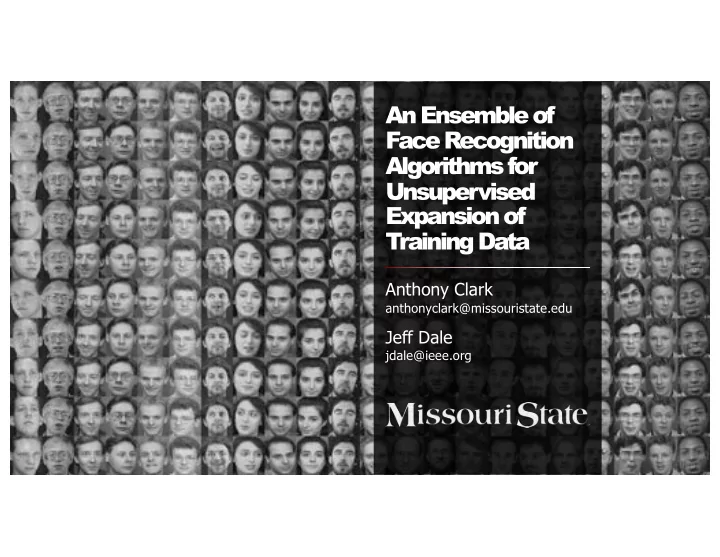

An Ensemble of Face Recognition Algorithms for Unsupervised Expansion of Training Data Anthony Clark anthonyclark@missouristate.edu Jeff Dale jdale@ieee.org
Motivation Security Smart Surveillance Deep Learning Small Data Ensemble Learners Ability to unlock personal Send alerts when On big data, deep Big data is nice, but The herd often makes devices with faces unknown persons appear learning approaches are difficult to obtain better decisions than the on premises unparalleled individual Clark, Dale 2
Problem How accurate can face recognition methods be with the smallest possible training data? Small Training Large Testing ○ One known face per subject given ○ Many unlabeled faces needed ○ Many subjects possible ○ So that we can validate our method ○ Goals: ○ Caveat: Augment training set with unlabeled All subjects in testing must appear in • • faces from testing set. training Do not introduce incorrect labels to • training set Clark, Dale 3
Our Approach We used four classical algorithms in a face recognition ensemble and created a novel voting strategy Eigenfaces Fisherfaces Uses PCA to create “Eigenfaces” Like Eigenfaces, but uses LDA over PCA Local Binary Pattern Histograms Randomized PCA Examines relative intensities around each pixel Like Eigenfaces, but computes PCA differently Clark, Dale 4
Common Ensemble Method Many ensemble method use majority voting Fisherfaces Jeff : ) Local Binary Pattern Histograms Jeff 3 Votes Jeff Jeff 1 vote Anthony Randomized PCA Jeff Eigenfaces Anthony New Face Trained Models Predictions Majority Vote Prediction Clark, Dale 5
Proposed Ensemble Method Our ensemble method take into account the confidence of each model Fisherfaces Jeff : ) Local Binary Pattern Histograms Jeff 3 Low Confident Votes Jeff Anthony 1 High Confident Anthony Randomized PCA Jeff Eigenfaces Anthony New Face Trained Models Predictions Confidence Vote Prediction Clark, Dale 6
Proposed Ensemble Method Our ensemble method take into account the confidence of each model How do we determine confidence? Fisherfaces Jeff 1 Low Confident : ) Local Binary Pattern Histograms Jeff Vote Jeff 2 Medium Confident Jeff Votes Jeff 1 High Confident Randomized PCA Jeff Anthony Eigenfaces Anthony New Face Trained Models Predictions Confidence Vote Prediction Clark, Dale 7
Ensemble Confidence A novel way to combine component algorithm distance measures ○ ! " - distance between testing face # " and nearest neighbor among $ training faces % . ○ Confidence: probability that a random distance is greater than the observed distance. For multiple algorithms, combine distances by summation. ○ PDF & ' ( is estimated using kernel density estimation, integral transformed and evaluated with Gaussian quadratures. Clark, Dale 8
Ensemble Method Idea: Treat high confidence agreements in component algorithms as truth and retrain components. Clark, Dale 9
Datasets We used popular small-to-medium sized datasets in face recognition. AT&T Faces Extended Yale Database B o 40 subjects o 38 subjects o 10 faces per subject o Varied faces per subject (2424 total images) o 112 × 92 pixel images o 192x160 pixel images o Grayscale o Grayscale F . S. Samaria and A. C. Harter, “Parameterisation of a stochastic model for A. S. Georghiades, P . N. Belhumeur, and D. J. Kriegman, “From few to human face identification,” in Proceedings of the Second IEEE Workshop many: Illumination cone models for face recognition under variable lighting on Applications of Computer Vision . IEEE, 1994, pp. 138–142. and pose,” IEEE transactions on pattern analysis and machine intelligence , vol. 23, no. 6, pp. 643–660, 2001. Clark, Dale 10
Tuning the Ensemble ○ Each ensemble method has a few parameters that Fisherfaces a user must specify ○ These parameters have a large impact on accuracy Local Binary Pattern Histograms ○ We used an evolutionary algorithm to tune these parameters Randomized PCA ○ These parameters were evolved in the ensemble method loop Eigenfaces Clark, Dale 11
Accuracy of the Ensemble 12 Clark, Dale
Ensemble as a Face Recognition Algorithm Evaluating the merit of the proposed ensemble in face recognition ○ Each pass adds additional training samples ○ These new samples are assumed to be correct, but they are never checked ○ Accuracy is over 5 replicate experiments ○ Points are fitted with logistic curve ○ Shading is standard deviation fitted with logistic curve Clark, Dale 13
Ensemble Confidence - Validation Evaluating the merit of the proposed confidence measure ○ ROC curve - false positive rate vs true positive rate varying confidence threshold ○ Data points considered are agreements in ensemble. ○ Can achieve over 90% true positive rate at 0% false positive (Dataset: AT&T Faces) ○ Number of added faces to training is sufficient for deep learning approaches to take over. Clark, Dale 14
Discussion What do these results show? ○ We have created two things: 1. A metric for assessing the confidence of a face recognition algorithm 2. An ensemble method that uses the confidence metric for predicting labels of new faces Our proposed ensemble method can be used to improve the performance of face recognition for application ○ with the following properties: 1. Only a few training examples are available 2. New samples will be collecting during the testing process New methods can be added the ensemble as long as they provide some form of distance ○ After enough new labeled (or predicted) samples are collected, a tool can switch over to a more accurate ○ system like the Inception-ResNet deep neural network face recognizer. Clark, Dale 15
Thank You Anthony Clark anthonyclark@missouristate.edu cs.missouristate.edu/AnthonyClark.aspx Jeff Dale jdale@ieee.org linkedin.com/in/jeff-dale-31aa5496/ https://github.com/jeff-dale/face-rec-ensemble
Recommend
More recommend